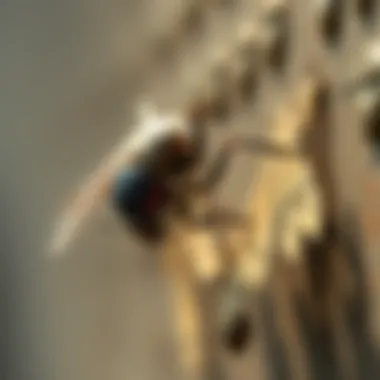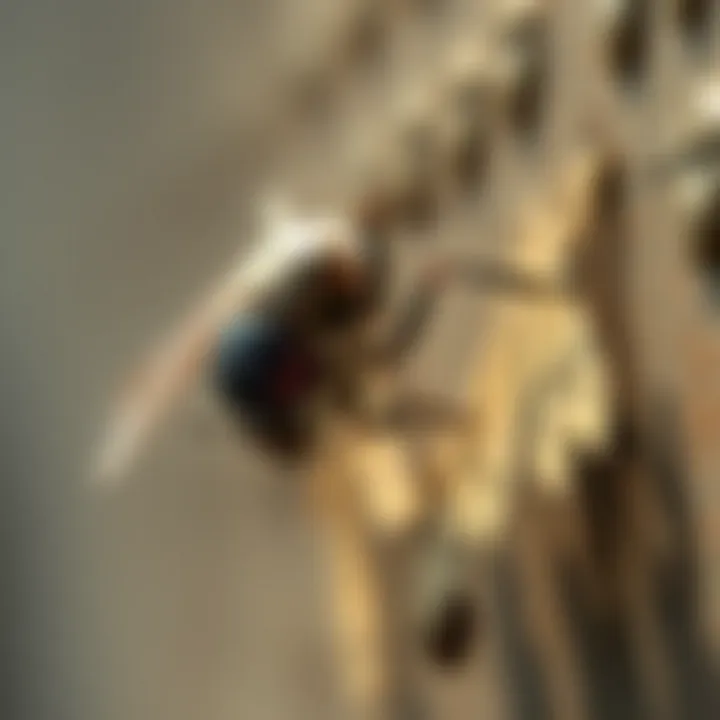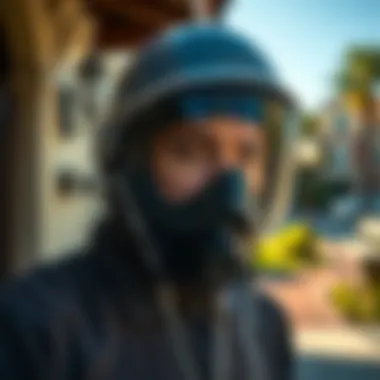Effective Bug and Pest Control Strategies in Venice, FL


Intro
Venice, Florida, with its sun-drenched shores and lush vegetation, is a paradise for many. However, this vibrant environment also serves as a haven for various pests and bugs. It's essential for homeowners in this beautiful locale to be aware of the challenges these unwelcome guests bring. Pest control isn't just about eliminating the instant annoyance; it’s about ensuring a comfortable and healthy living space for your family.
In this guide, we'll delve into effective strategies tailored for the local context of Venice, providing insights into pest identification, prevention methods, and even some do-it-yourself solutions that homeowners can adopt. Every pest story is unique, and understanding the local ecosystem will empower residents not only to tackle current infestations but also to prevent future ones.
Let’s kick things off by understanding the common culprits that might be lurking in your home.
Understanding the Pest Landscape in Venice, Florida
Understanding the local pest landscape is akin to knowing the lay of the land before you set out on an adventure. This insight is especially critical in a place like Venice, Florida, where the unique climate and environment create ideal conditions for various pests to thrive. Getting a grasp on the types of pests commonly found in the area not only helps residents take proactive measures but also enables them to react swiftly should unwanted visitors invade their homes.
Common Pest Species in Venice
In any community, several pest species tend to dominate, and Venice is no exception. Recognizing these common pests is key for homeowners looking to protect their living spaces from infestations.
Ants and Their Nesting Habits
Ants are some of the most persistent pests residents encounter. Often, they build nests in soil, under rocks, and even inside homes. Their ability to form large colonies means that if you see one or two, there are likely many more nearby. This aspect of their nesting habits can lead to significant problems if not addressed swiftly.
Ants are particularly attracted to food sources, and understanding their behaviors can aid in preventing infestations. Taking a proactive approach by sealing off food and cleaning up areas where crumbs may gather is a sound practice to deter their presence.
Termite Threats and Identification
Termites represent another level of pest menace, often identified as the silent destroyers of wooden structures. Given the humid climate of Venice, these pests thrive, making it essential for homeowners to be vigilant. They tend to remain hidden, often causing significant damage before they are even noticed.
One crucial aspect of termite identification is knowing what to look for—such as mud tubes on walls or wood that sounds hollow when tapped. Early detection is vital, as once they establish themselves, they're notoriously difficult to eliminate.
Rodents: Signs of Infestation
Rodents can often go unnoticed until the problem escalates. The signs of an infestation can include droppings, gnaw marks on furniture or walls, and strange noises at night. Their ability to reproduce quickly can make a small issue a larger one if not addressed soon.
Given their quick reproduction rate, recognizing early signs of rodent activity can significantly reduce the risk of an infestation spreading. Cleaning up potential food sources and keeping homes sealed are practical steps to keep these critters at bay.
Florida-Specific Bed Bugs
Bed bugs have seen a resurgence across the U.S., and Florida, with its warm climate, can be particularly susceptible. They're known for hitching rides on luggage and clothing, making their discovery often a plague for travelers and residents alike.
These pests are not just a nuisance; they can lead to sleepless nights and itchy skin.
Understanding the nature of bed bug infestations—how they operate, their breeding cycles, and the means of transport—can provide homeowners valuable insights in dealing with this issue.
Environmental Factors Influencing Pest Activity
Climate and Its Impact on Recommendations
The climate in Venice plays a not-so-small part in influencing pest activity. Warm weather year-round means certain pests can breed and proliferate in ways that they might not in cooler, northern climates. Hot, humid conditions particularly favor creatures like mosquitoes and termites, creating a continual need for vigilant pest management.
Conscientious homeowners should consider seasonal trends when tackling pest problems. Adapting pest control methods to shifting climatic patterns is key to effective management.
Housing Structures Vulnerable to Infestations
The architectural style of homes in Venice also influences how susceptible they are to pest invasions. Structures built with wood and those featuring cracks or gaps in foundations can provide ideal nesting sites for termites and rodents. Awareness of these vulnerability points should be at the forefront for those maintaining their abodes.
Identifying such structural weaknesses early will help homeowners implement necessary repairs before pests move in. Regular inspections can serve as a useful tool in this preventative strategy.
Local Flora and Pest Interactions
Finally, the native vegetation in Venice can attract various pests. Some plants can serve as unintended hosts, fostering pest populations. This interaction between local flora and pests means that gardening choices can inadvertently influence pest presence in the home.
Selecting plants known to repel pests can significantly reduce the presence of unwanted visitors. Knowledge of the local ecosystem can be a potent weapon in protecting one’s home from pests.
Effective Prevention Techniques
Effective prevention techniques are the first line of defense in maintaining a pest-free home. By employing strategic methods, residents of Venice, Florida can significantly reduce pest populations before they become a problem. It is far better to prevent infestations than to deal with the fallout. A clean home isn’t just about aesthetics; it's about keeping bugs and critters at bay. By integrating good practices into daily life, homeowners play a crucial role in pest control. This segment delves into actionable sanitation practices and sealing entry points that make a measurable difference.
Proper Sanitation Practices


Kitchen Cleanliness and Food Storage
Kitchen cleanliness is arguably one of the most critical components of effective pest control. When a kitchen is not well-maintained, it becomes an open invitation for pests like ants, roaches, and mice. Traces of food left behind can attract an army of critters. It’s vital to keep surfaces clean and store food properly—sealing items in airtight containers prevents pests from having easy access.
An advantage of maintaining a tidy kitchen is that it not only stops pests but also promotes a healthier living space. Regular cleaning encourages a habit that keeps both the home environment and food safe from contamination. Many pest issues could be avoided simply by washing dishes promptly, wiping counters after meal prep, and taking out the trash regularly.
Yard Maintenance and Waste Management
Outdoor spaces can be just as inviting for pests as the interior of the home. Regular yard maintenance is pivotal in discouraging pest infestations. Overgrown grass, weeds, and piles of debris can provide excellent hiding places for various insects and rodents. Thus, keeping the yard tidy minimizes these potential pest havens.
Additionally, proper waste management practices, like composting away from the home and using bins with covers, are essential. This unique feature adds a layer of control, ensuring that food scraps do not attract unwanted guests. However, the downside is that maintaining yard cleanliness requires effort and time, which can be a challenge for busy homeowners.
Indoor Clutter: Addressing Potential Hiding Places
Indoor clutter is another major contributor to pest infestations. Piles of clutter not only create stress but also provide hideouts for pests. It’s important to regularly declutter homes, especially areas like basements, attics, and storage closets, where unwanted guests may lurk.
An appealing aspect of addressing indoor clutter is the newfound space and peace of mind it brings. Moreover, knowing that there are fewer places for pests to hide can offer homeowners a sense of control over their living environment. One potential disadvantage can be the time it takes to organize spaces thoroughly, but the rewards often outweigh the efforts invested.
Sealing Entry Points
Inspecting Windows and Doors
Many pests enter homes through windows and doors, making regular inspections a fundamental practice. A home with gaps or poorly-fitted screens can be an easy target for wandering pests. Homeowners should routinely check window seals and door frames for cracks or openings. Addressing these issues can curtail entry points significantly, keeping invasive species outdoors.
The main benefit here is the sense of security that accompanies a tightly sealed home, minimizing not just pests, but also the potential intrusion of drafts. However, identifying these areas often requires diligence and sometimes even professional assistance, which can come with additional costs.
Utilizing Caulk and Weather Stripping
Applying caulk and weather stripping can provide an effective solution in sealing gaps. These materials are designed to fill voids and reinforce areas around doors and windows, ensuring pests have no easy passage. Homeowners can easily apply caulk themselves, making it a cost-effective choice.
A unique feature of using caulk is that it also serves to improve energy efficiency in the home. This dual advantage of saving on energy bills while warding off pests makes it an appealing strategy. However, some might find caulk challenging to apply evenly, which could lead to a less-than-perfect finish.
Maintaining Structural Integrity
Finally, maintaining the structural integrity of the home is paramount. This includes regular inspections for signs of water damage, gaps in foundations, or rotting wood—all potential entry points for pests. Keeping structures intact also plays a significant role in the overall safety and longevity of the home.
The key characteristic of maintaining structural integrity is that it involves proactive measures, like repairing cracks and replacing rotting wood, which can save homeowners from costly repairs down the line. Nevertheless, these maintenance tasks can be time-consuming, and some homeowners might need to hire professionals for comprehensive inspections.
Traditional and Modern Pest Control Methods
When it comes to safeguarding homes in Venice, Florida, understanding pest control methods is essential. Both traditional and modern approaches have their merits, and often, a combination of both works best. Knowing when to apply each method and the nuances they entail can greatly affect the outcome of pest management efforts.
Chemical Treatments
Understanding Pesticide Options
Chemical treatments remain a common approach for pest control, especially when infestations are severe. Choosing the right pesticide can make all the difference. Some chemical options tend to focus solely on killing the pests, while others may also repel them from returning. Popularity often lies in the effectiveness and speed of these products. However, one must consider their potential impact on both health and the environment.
There are various formulations available—liquids, granules, and even sprays—which allow homeowners to tailor their approach. It’s crucial to read labels carefully to determine if a product is safe for indoor use or targeted at specific pests. For instance, if you're tackling a cockroach problem, an insecticide specifically designed for that pest might just do the trick without affecting other areas of your home.
Application Techniques and Timing
Proper application techniques and timing can amplify the effectiveness of chemical treatments. First off, the technique can vary based on the type of pest involved; for example, a bait method might work wonders for ants, while a spray might be better suited for a wasp nest.
Timing is equally vital—applying treatments in the early morning or late evening when pests are most active can lead to better outcomes. However, it’s equally important to avoid applying too close to rain or irrigation, as this could wash away the chemicals before they have the chance to work. When you hit the mark with both technique and timing, you're more likely to see a significant reduction in pest populations.
Safety Precautions and Environmental Concerns
When handling any pesticide, safety should always be top of mind. Use protective gear like gloves and masks to prevent exposure. Further, proper ventilation is essential, especially in enclosed spaces. Beyond personal safety, there’s a pressing concern regarding environmental impact. Some chemicals can harm non-target organisms, including beneficial insects like bees.
For residents in Venice, being conscious of these factors is essential in making informed choices when it comes to pest control. Opting for products that have been proven to cause minimal environmental disruption can be seen as a responsible approach to taking control of pest issues while also considering the surrounding habitats.
Biological Control Methods
Utilizing Natural Predators
Biological control methods focus on harnessing nature to manage pest populations. Utilizing natural predators is an increasingly popular method among environmentally-conscious homeowners. By introducing or encouraging predators—like ladybugs for aphids or certain parasitic wasps—you create a natural balance in your garden or home.


This method not only reduces pest populations but also promotes biodiversity. It’s a gentle approach that minimizes chemical use, which is often seen as a big win for residents seeking a more eco-friendly lifestyle.
Microbial Pest Control
Microbial pest control offers an innovative method using naturally occurring microorganisms to target pests. For example, certain bacteria can be applied in a way to specifically disrupt the life cycle of pests like caterpillars. This method is gaining traction, as it is seen as a less harmful alternative to chemical pesticides.
One unique feature of microbial control is its targeted action; it often does not affect beneficial insects and has minimal environmental impact. Yet, it may require repeated applications for effectiveness, leading to considerations of time and effort for homeowners.
Integrated Pest Management Practices
Integrated pest management (IPM) is a holistic approach that combines various pest control strategies, both traditional and modern. This practice aims to manage pests through a comprehensive plan that includes regular monitoring, preventative measures, and targeted treatments.
One of the key characteristics of IPM is its adaptability. Homeowners are encouraged to assess the pest situation and adjust strategies based on current conditions. This method allows for sustainable practices while also being responsive to changes within the environment. However, its effectiveness hinges on consistent monitoring and a good understanding of local pest behaviors.
DIY Pest Control Solutions
When folks think of pest control, many might picture professionals with their fancy equipment and poisons. But there's a whole world of DIY pest control solutions that can be quite effective, especially for residents of Venice, Florida. Tapping into these methods offers a distinct blend of accessibility, cost-efficiency, and environmental friendliness. Not only can you tackle those pesky invasions at home, but you also gain a sense of empowerment in maintaining a pest-free environment.
Home Remedies for Common Pests
Natural Repellents for Ants
Natural repellents for ants are a centerpiece in the DIY pest control toolkit. Certain household items like vinegar, baking soda, or essential oils can deter these little critters effectively. For instance, using a vinegar solution at entry points can not only make them think twice before crossing the threshold but also cuts down on harsh chemicals polluting your space.
A significant characteristic of natural repellents is their safety for children and pets, unlike many commercial options. However, keep in mind that while they can divert ants from your immediate space, they often don't eliminate the nest. Users must recognize the need for persistence; it’s about tosetting a boundary rather than wiping out the enemy.
Essential Oils and Their Effectiveness
Essential oils have gained traction in the realm of pest control for their pleasant fragrances and pest-busting capabilities. Oils like peppermint, tea tree, and lavender are commonly touted for repelling everything from mosquitoes to spiders. Their key strength lies in their dual ability to freshen up a room while keeping unwanted insects at bay.
A unique feature of using essential oils is the composition being biodegradable and non-toxic. Given their relatively low cost, many households opt for this as a preferred solution. However, the effectiveness may vary depending on the specific type of pest; some oils might work wonders on certain insects while falling short against others. Thus, it's prudent to experiment and find the best fit for your particular pest problem.
Traps and Baits for Rodents
Rodent traps and baits are quintessential elements for tackling rodent infestations, especially in homes. These can vary from traditional snap traps to more modern designs like electric traps. One main characteristic is their ability to provide a straightforward solution with visible results. Most people appreciate the simplicity, as they can see when a trap has worked.
However, it’s important to be mindful of placement; traps should be strategically positioned near heavily traveled rodent pathways. The unique aspect of traps and baits is that they're often reusable or easily disposable, making them an economical option in the long run. Yet, it's crucial to monitor them closely to prevent distress for the animals or lingering odors from dead rodents. The combined vigilance in monitoring and strategically using these tools creates a more effective DIY approach.
Creating a Pest Prevention Plan
Establishing a pest prevention plan is akin to putting up a solid fence against unwanted guests. With the right strategies in place, you can effectively keep pests at bay, ensuring your home remains a sanctuary from the outside world.
Routine Inspections and Monitoring
Conducting routine inspections and monitoring should be a cornerstone of any pest prevention plan. Taking a walk around your property and checking for signs like droppings, nests, or even a few stray exterminated pests helps you assess the level of lurking infestations. It's not just about immediate remedies; it's about catching problems before they bloom into significant infestations.
Regular visual checks allow homeowners to feel more engaged and informed about their environment, empowering them to tackle issues head-on. Moreover, allocating time monthly or seasonally encourages consistent maintenance and awareness of potential pest-friendly conditions, cultivating a proactive approach while minimizing future disruptions.
Seasonal Adjustments to Methods
As seasons change, so do pest behaviors. Adjusting your methods seasonally is indispensable for effective pest control. For instance, in Florida’s spring and summer, pests tend to be more active, necessitating a more rigorous approach. Conversely, as temperatures drop, certain pests, including cockroaches and termites, may seek refuge indoors, demanding a recalibration of tactics.
The seasonal adaptability of your plan ensures you’re not using ineffective methods outside their prime time. With adjusted strategies, you create a dynamic toolset ready to face these changes head-on, allowing homeowners to stay one step ahead of potential invaders.
Educating Family Members on Pest Awareness
Informing family members about pest awareness is often overlooked but is vitally important for a holistic DIY pest control strategy. Children should know what to look out for, like signs of ants, how to store food properly, and the importance of hygiene around the house. This collective knowledge breed sings together a community of safety and vigilance within your home.
By engaging family members in pest control discussions, you not only foster understanding but build a sense of responsibility in combating pests. It allows everyone to play their part. Knowledge shared is power gained, which ultimately strengthens the effectiveness of any pest prevention plan.
When to Seek Professional Help
Dealing with pests in your home can often feel like a race against time. Sometimes, the DIY methods you’ve come to rely on might not cut it, leading you to consider bringing in the experts. Knowing when to seek professional help is crucial in maintaining a healthy and pest-free home environment. It's not just about getting rid of pests; it's also about protecting your home and family from potential hazards those critters bring.
Identifying the Severity of Infestations
Signs Indicating Professional Intervention


There comes a moment when you might notice a few ants marching across your kitchen counter. It starts with one here and one there, but if you gaze into the pantry one day and find a rogue colony feasting on your flour, you might realize it’s time to call in the pros. Common signs include droppings, gnawed wires, or small nests. If the infestation has spread beyond your control or is disrupting daily life, that’s a big indicator that professional help is necessary.
The key characteristic of recognizing the severity lies in understanding the potential damage these pests can cause. A small leak can turn into a flood if not managed correctly, just like a little ant problem can escalate into a full-on invasion. By addressing the issue swiftly, you not only save time but possibly hundreds of dollars in repairs.
"A stitch in time saves nine"—the old adage applies here. The sooner you address the infestation, the less chance it has to wreak havoc on your home.
Assessing Risks to Health and Property
When pests invade, it's not just your peace of mind that’s at stake. There are real risks of allergens, bites, and even diseases lurking behind those critters. The assessment of health and property risks should always be on your radar. For instance, rodents can carry harmful pathogens, while termites can weaken the very foundations of your house.
It’s essential to consider how the pests present could impact not just your property but also your loved ones. Children, elderly folks, and pets might be more susceptible to health issues stemming from pest infestations. Considering these factors helps you determine whether your situation is dire enough for professional intervention, adding a layer of urgency to the decision.
Consultation Services Available in Venice
Venice offers numerous pest control services. From local businesses to larger companies, the options to consult with trained pest control professionals are plentiful. Each service has its unique features, such as specialized treatments for termites or innovative methods for managing rodent infestations.
When looking for professional help, you want to find a service that stands out. Look out for licensed experts who use proper techniques suited to the Floridian climate. Local professionals often understand the specific pests that plague your area better than anyone else. They are well-versed in identifying issues unique to a coastal environment, giving you that tailored service you may seek.
Connecting with a consultation service in Venice not only gives you access to necessary expertise but also lends peace of mind. The major advantage here is knowing that your pest issues are being handled by knowledgeable individuals who can provide guaranteed results. However, ensure to check reviews and get recommendations to find the right fit for your home.
Choosing a Pest Control Service
Researching Credentials and Reviews
When the time comes to choose a pest control service, starting with their credentials is paramount. You want a solid background and proven track record. Reading through client reviews offers a glimpse of their reputation in the community. A service that prioritizes transparency and customer feedback usually builds trust.
Check for license numbers, any pertinent accreditations, and years of experience they have in the field. These components add to their authority and reliability in handling your pest-related issues.
Understanding Treatment Plans and Costs
Understanding the nitty-gritty of treatment plans and costs is vital. Different services may offer an array of treatment options, and costs can vary wildly based on what you require. Residential pest control often can range from simple inspections to full-blown treatment plans involving multiple visits. By asking for itemized quotes, you gain clarity on what’s included in the services, avoiding sticker shock.
It’s wise to compare prices but remember that the cheapest option may not necessarily be the best. Quality matters just as much as cost for reliable pest control.
Evaluating Customer Service and Responsiveness
Last but not least, the quality of customer service and how promptly pest control personnel respond can be indispensable. Imagine needing an urgent last-minute service and being kept on hold for ages. Companies that respect your time and provide efficient service often leave a more favorable impression.
Check how they handle inquiries—are they eager to answer your questions? Do they provide clear explanations of their processes? The ability to communicate and respond quickly can make all the difference, especially during a dire pest situation. A responsive service goes hand-in-hand with effective solutions, assuring you that your concerns are heard and handled accordingly.
Sustainable Pest Management Practices
In the ever-evolving landscape of pest control, the emphasis on sustainability has taken center stage. It is evident that a balanced approach not only tackles the immediate problem of pests but also respects the delicate ecosystems within which we all coexist. Such practices are very important in Venice, Florida, where the local climate and environment can easily influence pest behavior and management. By adopting sustainable practices, residents can minimize chemical usage, protect their family, and preserve the environment all at once.
Eco-friendly Products and Techniques
Biodegradable Pesticides
Biodegradable pesticides offer an alternative to traditional chemical solutions. Their primary value lies in their ability to break down into harmless substances after achieving their intended purpose. This characteristic makes them favorable, as they reduce the risk of long-term environmental contamination. While biodegradable products are popular for their safety, their effectiveness can sometimes be variable depending on specific pests. It's crucial to read product labels and understand how these pesticides will impact both your target pest and the surrounding ecosystem. The biggest advantage is that they provide a safe option for controlling pests without harming beneficial insects or the environment. However, they may require more frequent applications, as they often degrade faster than synthetic alternatives.
Organic Gardening to Prevent Infestation
Organic gardening is another effective strategy against pests that aligns beautifully with the principles of sustainability. This approach emphasizes the use of natural fertilizers and pest deterrents, avoiding synthetic chemicals altogether. By cultivating plants suited to local conditions, homeowners in Venice can reduce pest attractants and promote resilience among their crops. A major perk of organic gardening is the improved health of the soil and surrounding flora. However, it requires a certain level of commitment and knowledge about local gardening practices. Some might find it labor-intensive compared to conventional gardening, but the long-term benefits for both pest control and the environment are profound.
Utilizing Native Predatory Species
Embracing native predatory species offers a practical twist in sustainable pest management. Employing beneficial insects or animals that naturally prey on the pests can establish a balanced ecosystem. This techique not only curtails pest populations but also ensures that the local biodiversity thrives. Ladybugs, for instance, feast on aphids, effectively acting as nature’s pest control agents. One of the appealing features of using native species is their adaptation to the local environment, ensuring that they will thrive without disrupting existing ecosystems. Yet, caution must be taken to avoid introducing non-native species, which can exacerbate pest problems rather than resolve them.
The Role of Community in Pest Control
Neighborhood Awareness Programs
Implementing neighborhood awareness programs allows residents to share tips and strategies on pest control methods that are both effective and eco-friendly. These programs promote a collaborative spirit, encouraging participants to learn from one another’s experiences and successes. The key benefit of this approach is the sense of community that develops through shared goals. When homeowners become aware of pest issues in their vicinity, they can address common problems more effectively together than alone. While fostering community engagement, there is always the risk of misinformation regarding pest control methods, which can arise without proper guidance.
Collaborative Efforts in Pest Management
Collaborative efforts can prove invaluable in pooling resources and knowledge regarding pest management. When neighbors come together, they can enact large-scale prevention measures that may be too cumbersome for an individual household. This not only enhances pest control effectiveness but also raises community awareness about sustainable practices. However, trust and transparency must be maintained among participants, or friction may arise when differing opinions on pest management emerge.
Educational Workshops for Residents
Educational workshops serve as a cornerstone for teaching residents about sustainable pest control practices. These workshops can provide hands-on experience and expert insights into methods for managing pests sustainably. Attendees can ask questions, gain practical knowledge, and create their tailored pest prevention plans for their homes. The unique feature of workshops is that they empower individuals, giving them tools and confidence to tackle pests without turning to harsh chemicals. Nonetheless, participation sometimes dips, as busy schedules may hinder residents from attending.
By prioritizing sustainable pest management, residents can successfully control pests while protecting their immediate environment. It represents a holistic approach to pest control, ensuring the safety of both people and nature in beautiful Venice, Florida.















